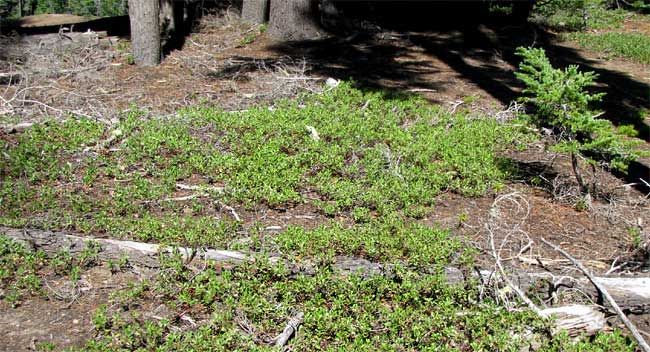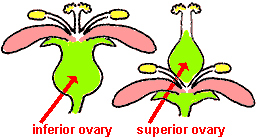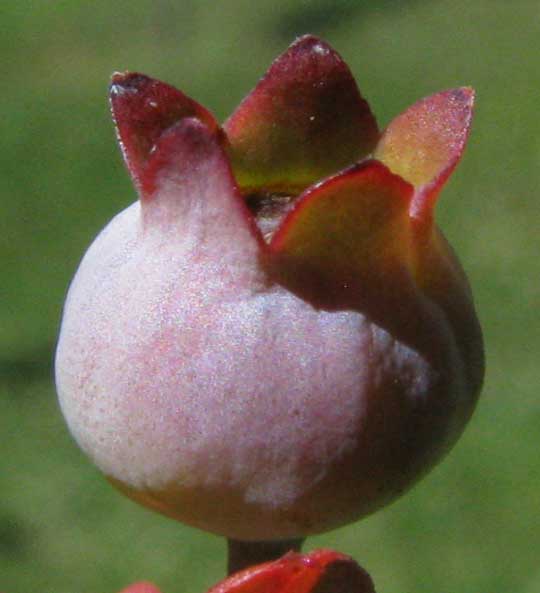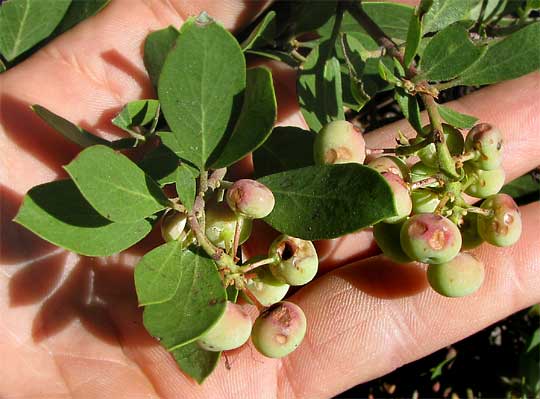Excerpts from Jim Conrad's
Naturalist Newsletter

from the the August 16, 2009 Newsletter, reporting on a visit to Rogue River National Forest in southwestern Oregon:
HUCKLEBERRY PUZZLEMENT
Descending westward from Crater Lake we entered Rogue River National Forest. It was fascinating watching the vegetation change from sparse, deserty, tree-line communities at the crater's rim into the lower elevations' relative lushness. One zone we passed through, a Douglas-fir forest at maybe 5500 feet in elevation, was striking because the relatively open forest floor was thickly carpeted with an evergreen, woody shrub only about a foot high, as shown above.
The mat-forming shrub bore fruits looking like blueberries. Though unfamiliar with huckleberries I knew that huckleberries are a kind of blueberry, and we were near the Forest Service's Huckleberry Mountain Campground, so I thought that maybe these were huckleberry plants.
 However, the fruits, while similar to what I imagined huckleberries might look like, weren't quite right. All blueberry fruits and therefore all huckleberry fruits are developed from "inferior ovaries." Inferior ovaries are those with corolla, calyx and other parts arising above the ovary, not below it, as diagrammed at the right.
However, the fruits, while similar to what I imagined huckleberries might look like, weren't quite right. All blueberry fruits and therefore all huckleberry fruits are developed from "inferior ovaries." Inferior ovaries are those with corolla, calyx and other parts arising above the ovary, not below it, as diagrammed at the right.
One consequence of the inferior ovary is that blueberry fruits -- therefore huckleberries as well -- clearly bear their persistent calyxes opposite their stem attachment. An immature blueberry from our garden plainly showing the 5-sepaled calyx persisting atop the fruit is below:

Compare that with the fruits on the mat-forming shrub below:

Little dimples mark the fruits' ends opposite their points of attachment but there are no calyxes or calyx scars. This is no blueberry, and therefore no huckleberry.
The mat-forming shrub is a manzanita species. The much larger, shrubby Whiteleaf Manzanita, Arctostaphylos viscida, is abundant around my trailer, profiled at http://www.backyardnature.net/n/w/manzanit.htm, but what we have here is the higher-elevation-growing Pinemat Manzanita, ARCTOSTAPHYLOS NEVADENSIS.
Though I was disappointed at still not learning about huckleberries, it's clear from mouse nibblings on the immature fruits in the picture that when the millions and millions of Pinemat Manzanitas covering many acres of forest floor in that area bear mature fruits, someone will have a banquet. The fruits are listed as important food items for Black Bear, Black-tailed Deer, Coyote, birds and miscellaneous rodents. Black- tailed deer browse the shrub's seedlings during the first three years after a fire, and after fires Pinemat Manzanita often is very plentiful because its soil-stored seed vigorously germinate after fire.
Pinemat Manzanita occurs from Washington State through Oregon into California, and a bit of Nevada.